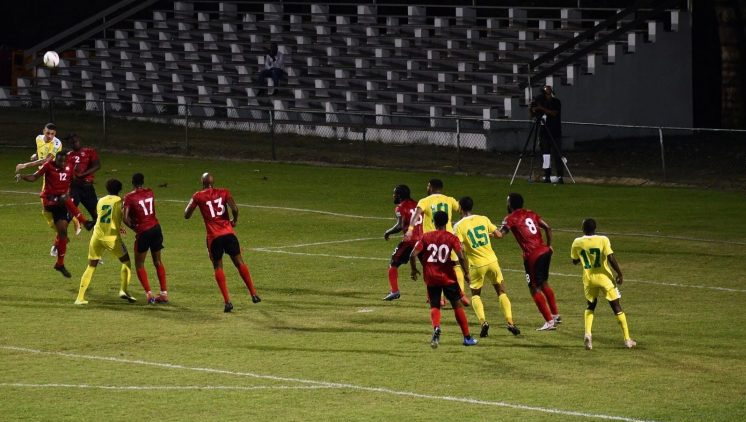The Golden Jaguars opening match defeat on Thursday against traditional Caribbean rival Trinidad and Tobago in the 2022 FIFA World Cup Qualifiers in the Dominican Republic, has ignited the debate on various platforms on the tactics employed.
The Marcio Maximo coached outfit was easily brushed aside by the ‘Soca Warriors’ 3-0 compliments of a double from Ryan Telford and a solitary strike from Levi Garcia.
The Golden Jaguars employed a 4-2-3-1 formation, which consisted of (GK) Akel Clarke, Miguel Scarlett, Terrence Vancooten, Matthew Briggs, Kadell Daniels, Sam Cox, Daniel Wilson, Keanu Marsh-Brown, Callum Harriott, Trayon Bobb and Emery Welshman.
However, formations are utilised based on the composition and quality of the squad.
A 4-2-3-1 formation is widely noted for its overall balance due to its fluidity in offensive and defensive schemes.
The formation is a reinvention of the traditional 4-5-1 formation which is rooted in defensive ethos.
In terms of strengths, the formation is tailored for teams that are coached to utilise quick and intricate passing schemes from within the midfield and final third while maintaining defensive stability within the same area.
This highlights the fluidity of the formation as five players can attack at any given time and six players can defend if required, when in transition.
Presently, the 4-2-3-1 is being utilised with ruthless efficiency by Hansi Flick of current Champions League holder Bayern Munich, which highlights its effectiveness once the team possesses the requisite quality.
The weakness of the formation is that it is personnel specific especially in the midfield third and its lack of natural width following the utilization of wide midfielders and not wingers who operate within the proximity of the 18-yard area, further highlighting its defensive nature. This formation also relies on the fullbacks to provide the necessary width via overlapping runs.
The importance of the double pivot, the ‘2’ [ defensive midfielders] within the aforesaid formation, cannot be understated as it is the positions which gives the playing structure balance on both sides of the field. Traditionally, a ball winning or ‘box to box’ midfielder was often paired with a deep lying creative player in this setup.
However, the evolution of the game has forced a dynamic change. Both players are expected to serve as the bridge between defence and offence. As such, their skill set must contain qualities such as tackling, dribbling, passing, shooting, stamina and avoiding the press.
In Guyana’s case, the two pivots, Captain Samuel Cox and Daniel Wilson, were ill equipped for their natural function.
Cox is naturally a right fullback and has never displayed the requisite offensive quality or ‘box to box’ talents to function in the evolved role.
Wilson, who is technically more gifted than his skipper, lacks the robustness and dribbling qualities associated with the position.
The ineffectiveness of the duo was compounded by the No.10, in this case Marsh-Brown, failing to act as third midfielder on a consistent basis both defensively and offensively in the midfield third.
This situation created numerical handicaps on a constant basis which were exploited by the ‘Soca Warriors’.
Similarly, the lack of width was evident on both ends, as Harriott and Bobb were forced to carry out defensive duties throughout the majority of the contest owing to the nonexistence of overlapping patterns from fullbacks Daniels and Scarlett. Overlapping plays serve not only as a direct threat, but as a ‘false play or trick play’, which is important to this formation. Simply put, the team lacked the quality to employ this structure especially against seasoned teams. A change is certainly expected and required.
Meanwhile, experienced local tactician and former national player Mark ‘Seven’ Charles, lambasted the team for their abject performance against the twin-island republic, noting, “It was an abjectly poor performance, on a scale of 1-10, I would give them a five. It was a very bad performance. The team was very low in their tactical awareness and as a former national football player, COVID-19 should not be the excuse because as a national football player, you are being paid as a professional so your body and tactical awareness should always be at a high level. From my observation, there was a lack of communication between the coaching staff and the players. In this sense, meaning that, it seemed like the players are going through motions because on the field of play there is no communication.”
He added, “There seems to be a vast difference between the concept of what the coach wants and what the players do on their own. Football is about instruction on the field of play, there was no cohesion, and the players could not put together two or three passes. They were struggling in their various roles and functions. Take the left-back as an example, when the ball was coming across, he had the first opportunity to stop the cross which led to the second goal. On the first goal, the center-back was supposed to step forward and shut down the danger. We truly also need better midfielders.”
According to Charles, the coaching staff has to shoulder the responsibility for the loss.
“The coaching staff is to blame for that debacle, there is no problem in players improvising but the coaching staff is the general and the players must work towards the general’s instructions.”
Guyana will continue their Group ‘F’ campaign against The Bahamas on March 30.
Only the group winner will progress to the second stage of the qualifiers.





